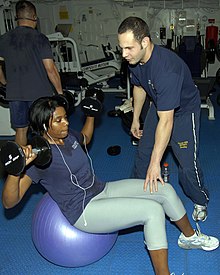Exercise ball

An exercise ball is a ball constructed of elastic soft PVC with a diameter of approximately 35 to 85 centimeters (14 to 34 inches) and filled with air. The air pressure is changed by removing a valve stem and either filling with air or letting the ball deflate. It is most often used in physical therapy, athletic training and exercise.
The ball, while often referred to as a Swiss ball, is also known by a number of different names, including balance ball, birth ball, body ball, ball, fitness ball, gym ball, gymnastic ball, physioball, pilates ball, Pezzi ball, sports ball, stability ball, Swedish ball, therapy ball, or yoga ball. It is larger and much lighter than a medicine ball.
History
The physical object known as a "Swiss Ball" was developed in 1963 by Aquilino Cosani, an Italian plastics manufacturer. He perfected a process for molding large puncture-resistant plastic balls. [1] Those balls, then known as "Pezzi balls", were first used in treatment programs for newborns and infants by Mary Quinton, a British physiotherapist working in Switzerland. Later, Dr. Susanne Klein-Vogelbach, the director at the Physical Therapy School in Basel, Switzerland, integrated the use of ball exercise as physical therapy for neuro-developmental treatment. Based on the concept of "functional kinetics"[2], Klein-Vogelbach advocated the use of ball techniques to treat adults with orthopedic or medical problems. The term "Swiss Ball" was used when American physical therapists began to use those techniques in North America after witnessing their benefits in Switzerland.[3] From their development as physical therapy in a clinical setting, those exercises are now used in athletic training[4], as part of a general fitness routine [5] and incorporation in alternative exercises such as yoga.[6]
Benefits

A primary benefit of exercising with an exercise ball as opposed to exercising directly on a hard flat surface is that the body responds to the instability of the ball to remain balanced, engaging many more muscles to do so.[7] Those muscles become stronger over time to keep balance. Most frequently, the core body muscles — the abdominal muscles and back muscles — are the focus of exercise ball fitness programs.[8]
Other uses
Some people sit on an exercise ball instead of a chair (for example, an office chair). This is based on the theory that the abdominal and back muscles are constantly engaged and active in order to maintain proper posture and balance on the ball. However, there is no scientific evidence of those benefits occurring by just sitting without additional exercises.[9][10] Using a Swiss ball as a chair is sometimes prescribed by physical therapists for back patients in sedentary jobs.[citation needed] However, some people warn against using a Swiss ball as chair due to ergonomical considerations.[11]
This large plastic ball, known as a "birth ball", can also be used during labour to aid the descent of the fetal head into the pelvis. Sitting in an upright position will also aid fetal positioning and is more comfortable for the woman. Sitting on the ball with arms placed on a bed, table or otherwise sturdy object for support and gently rocking the hips may help the woman during contractions and aid the natural physiological process of birth.[12]
Because of its large, resiliant, bouncy quality, the exercise ball is also used to play Circle Rules Football. This is an American team field sport that allows the players to kick, punch, and bounce the ball on a circular field with a single large goal in the center.[13]
See also
References
- ^ Flett, Maureen (2003). Swiss Ball: For Strength, Tone and Posture. Sterling Publishing Company, Inc. ISBN 185648663X.
- ^ Klein-Vogelbach, Susanne (1990). Functional Kinetics: Observing, Analyzing, and Teaching Human Movement. Springer-Verlag. ISBN 0387153500.
- ^ Carriere, Beate (1998). The Swiss Ball: Theory, Basic Exercises and Clinical Application. Springer. ISBN 3540611444.
{{cite book}}: Unknown parameter|coauthors=ignored (|author=suggested) (help) - ^ Hillman, Susan Kay (2005). Introduction to Athletic Training. Human Kinetics. ISBN 0736052925.
- ^ Milligan, James (2005). Swiss Ball For Total Fitness: A Step-by-step Guide. Sterling Publishing Company, Inc. ISBN 1402719655.
- ^ Mitchell, Carol (2003). Yoga on the Ball. Inner Traditions / Bear & Company. ISBN 0892819995.
- ^ Vera-Garcia FJ, Grenier SG, McGill SM (2000) Abdominal muscle response during curl-ups on both stable and labile surfaces. Phys. Ther. 80, 564-569
- ^ Mayo Clinic Staff (August 24, 2007). "Slide show: Core exercises with a fitness ball". Mayo Clinic. Retrieved April 2008.
{{cite web}}: Check date values in:|accessdate=(help) - ^ Gregory DE, Dunk NM, Callaghan JP (2006). "Stability ball versus office chair: comparison of muscle activation and lumbar spine posture during prolonged sitting". Hum Factors. 48 (1): 142–53. PMID 16696264.
{{cite journal}}: CS1 maint: multiple names: authors list (link) - ^ McGill SM, Kavcic NS, Harvey E (2006). "Sitting on a chair or an exercise ball: various perspectives to guide decision making". Clin Biomech (Bristol, Avon). 21 (4): 353–60. doi:10.1016/j.clinbiomech.2005.11.006. PMID 16410033.
{{cite journal}}: Unknown parameter|month=ignored (help)CS1 maint: multiple names: authors list (link) - ^ Ergoweb, Opinion: Balls as Office Chairs a Bad Idea
- ^ Wesson, Nicky (2000). Labor Pain: A Natural Approach to Easing Delivery. Inner Traditions / Bear & Company. ISBN 0892818956.
- ^ Official Circle Rules Football Website
